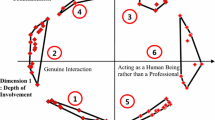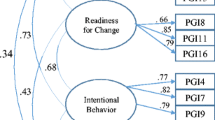Abstract
The purpose of this study is to examine the unfolding of counselor-client-rated real relationships over the course of counseling as well as to verify whether the change rate is associated with the treatment outcome with a Korean sample. In this study, data were collected from 71 Korean counselor/client dyads; the clients and counselors completed real-relationship measures (KRRI-C, KRRI-T) to assess the strength of their real relationship after the first, third, fifth, and eighth session of the counseling. Clients also completed the outcome measure (KOQ-30) before the first session and at the end of the eighth session. To analyze this, latent growth curve modeling (LGCM) was used. The results of the analysis are as follows: first, both client-rated and counselor-rated real relationship significantly increased linearly over the course of counseling sessions. Second, the client’s initial ratings and the change rate of the real relationship were significantly related with the treatment outcome. Third, the counselor’s initial ratings and the change rate of the real relationship were not related with the treatment outcome. Implications for future research and counseling practice are discussed.

Similar content being viewed by others
References
Ain, S. (2011). The Real Relationship, Therapist Self-Disclosure, and Treatment Progress: A Study of Psychotherapy Dyads (Doctoral dissertation, University of Maryland).
Ain, S. & Gelso, C. J. (2008). Chipping away at the blank screen: Self-disclosure, the real relationship, and therapy outcome. Poster presented at the annual convention of the North American Society for Psychotherapy Research, New Haven, CT.
Ain, S. & Gelso, C. J. (2011). Client and therapist perceptions of the real relationship and therapist self-disclosure: A study of dyads. Paper presented at the 2011 Convention of the North American Society for Psychotherapy Research, Banff, Alberta, Canada
Cho, H., & Seo, Y. S. (2017). Korean counselors’ perceptions of the real relationship in counseling process. Asia Pacific Education Review, 18(1), 135–146.
Choi, H. N. (2011). Validation study of the Korean version of Real Relationship Inventory-Therapist form. Korea Journal of Counseling., 12(1), 143–158.
Choi, H. N., Lee, E. J., & Kim, M. H. (2015). The unfolding of the real relationship in counseling: Effect of counselor and client attachment. Korea Journal of Counseling, 16(6), 135–158.
De Roten, Y., Fischer, M., Drapeau, M., Beretta, V., Kramer, U., Favre, N., et al. (2004). Is one assessment enough? Patterns of helping alliance development and outcome. Clinical Psychology & Psychotherapy, 11(5), 324–331.
Foreman, S. A., & Marmar, C. R. (1985). Therapist actions that address initially poor therapeutic alliances in psychotherapy. American Journal of Psychiatry, 142, 922–926.
Freud, S. (1957). Future prospects of psychoanalytic psychotherapy. In J. Strachey (Ed. & Trans.), Standard edition of the complete psychological works of Sigmund Freud (Vol. 11, pp. 139–151). London, England: Hogarth Press. (Original work published 1910)
Fuertes, J. N., Gelso, C. J., Owen, J. J., & Cheng, D. (2013). Real relationship, working alliance, transference/countertransference and outcome in time-limited counseling and psychotherapy. Counseling Psychology Quarterly, 26(3–4), 294–312.
Fuertes, J. N., Mislowack, A., Brown, S., Gur-Arie, S., Wilkinson, S., & Gelso, C. J. (2007). Correlates of the real relationship in psychotherapy: A study of dyads. Psychotherapy Research, 17, 423–430.
Gaston, L. (1990). The concept of the alliance and its role in psychotherapy: Theoretical and empirical considerations. Psychotherapy, 27, 143–153.
Gelso, C. J. (2009). The real relationship in a post-modern world: Theoretical and empirical explorations. Psychotherapy Research, 19, 253–264.
Gelso, C. J. (2011). The real relationship in Psychotherapy: The hidden foundation of change. Washington, DC: American Psychological Association.
Gelso, C. J., & Carter, J. A. (1985). The relationship in counseling and psychotherapy. The Counseling Psychologist, 13, 155–243.
Gelso, C. J., & Carter, J. A. (1994). Components of the psychotherapy relationship: Their interaction and unfolding during treatment. Journal of Counseling Psychology, 41, 296–306.
Gelso, C. J., & Hayes, J. A. (1998). The psychotherapy relationship: Theory, research, and practice. New York: Wiley.
Gelso, C. J., Kelly, F. A., Fuertes, J. N., Marmarosh, C., Holmes, S. E., Costa, C., et al. (2005). Measuring the real relationship in psychotherapy: Initial validation of the therapist form. Journal of Counseling Psychology, 52, 640–649.
Gelso, C. J., Kivlighan, D. M., Busa-Knepp, J., Spiegel, E. B., Ain, S., Hummel, A. M., et al. (2012). The unfolding of the real relationship and the outcome of brief psychotherapy. Journal of Counseling Psychology, 59, 495–506.
Gelso, C. J., Kivlighan, D. M., Wine, B., Jones, A., & Friedman, S. (1997). Transference, insight, and the course of time-limited therapy. Journal of Counseling Psychology, 44, 209–217.
Gelso, C. J., & Samstag, L. W. (2008). A tripartite model of the therapeutic relationship. In S. Brown & R. Lent (Eds.), Handbook of counseling psychology (pp. 267–283). New York: Wiley.
Goden, B. R., & Robbins, S. B. (1990). The working alliance within time limited therapy. Professional Psychology: Research and Practice, 21(6), 476–481.
Greenson, R. R. (1967). The technique and practice of psychoanalysis (Vol. 1). New York: International Universities Press.
Horvath, A. O., & Bedi, R. P. (2002). The alliance. In J. C. Norcross (Ed.), Psychotherapy relationships that work: Therapist contributions and responsiveness to patients (pp. 37–69). New York: Oxford University Press.
Horvath, A. O., Del Re, A. C., Flückiger, C., & Symonds, D. (2011). Alliance in individual psychotherapy. Psychotherapy: Theory Research, Practice, Training, 48, 9.
Horvath, A. O., & Marx, R. W. (1991). The development and decay of the working alliance during time-limited counseling. Canadian Journal of Counseling, 24, 240–259.
Howard, K. I., Kopta, S. M., Krause, M. S., & Orlinsky, D. E. (1986). The dose–effect relationship in psychotherapy. American Psychologist, 41(2), 159–164.
Kelly, F. A., Gelso, C. J., Fuertes, J. N., & Marmarosh, C. (2010). The real relationship inventory: Development and psychometric investigation of the client form. Psychotherapy Theory: Research, Practice, Training, 47(4), 540–553.
Kenny, D. B., Kaniskan, B. D., & McCouach, B. (2014). The performance of RMSEA in models with small degrees of freedom. Sociological Methods & Research, 44(3), 486–507.
Kim, C. D., Kwon, K. I., Han, Y. J., & Sohn, N. H. (2008). The Korean counselor’s factors which contribute to positive counseling outcomes. The Korea Journal of Counseling, 9(3), 961–986.
Kivlighan, D. M., Gelso, C. J., Ain, S., Hummel, A. M., & Markin, R. D. (2015). The therapist, the client, and the real relationship: An actor–partner interdependence analysis of treatment outcome. Journal of Counseling Psychology, 62(2), 314–320.
Kivlighan, D. M., Hill, C. E., Gelso, C. J., & Baumann, E. (2016). Working alliance, real relationship, session quality, and client improvement in psychodynamic psychotherapy: A longitudinal actor partner interdependence model. Journal of Counseling Psychology, 63(2), 149–161.
Kivlighan, D. M., & Shaughnessy, P. (1995). Analysis of the development of the working alliance using hierarchical linear modeling. Journal of Counseling Psychology, 42(3), 338–349.
Kivlighan, D. M., & Shaughnessy, P. (2000). Patterns of working alliance development: A typology of client’s working alliance ratings. Journal of Counseling Psychology, 47(3), 362–371.
Knox, S., Hess, S. A., Peterson, D. A., & Hill, C. E. (1997). A qualitative analysis of client perceptions of the effects of helpful therapist self-disclosure in long-term therapy. Journal of Counseling Psychology, 44(3), 274–283. https://doi.org/10.1037/0022-0167.44.3.274.
Lambert, M. J., & Barley, D. E. (2002). Research summary on the therapeutic relationship and psychotherapy outcome. In J. C. Norcross (Ed.), Psychotherapy relationships that work (pp. 17–36). New York: Oxford University Press.
Lee, E., Yang, N., & Seo, E. (2007). A qualitative study on counseling in Korea. The Korea Journal of Counseling and Psychotherapy, 19(3), 587–607.
Lee, E. J., & Choi, H. N. (2018). Longitudinal change patterns of working alliance and counseling outcome. Korean Journal of Counseling, 19(2), 365–385.
Leong, F. T. L., & Lopez, S. (2006). Culture, race, and ethnicity in psychotherapy (Special issue). Psychotherapy: Theory, Research, Practice, Training, 43
LoCoco, G., Gullo, S., Prestano, C., & Gelso, C. J. (2011). Relation of the real relationship and the working alliance to the outcome of brief psychotherapy. Psychotherapy, 48(4), 359.
Markin, R. D., Kivlighan, D. M., Gelso, C. J., Hummel, A. M., & Spiegel, E. B. (2014). Clients’ and therapists’ real relationship and session quality in brief therapy: An actor partner interdependence analysis. Psychotherapy, 51(3), 413–423.
Marmarosh, C. L., Gelso, C. J., Markin, R. D., Majors, R., Mallery, C., & Choi, J. (2009). The real relationship in psychotherapy: Relationships to adult attachments, working alliance, transference, and therapy outcome. Journal of Counseling Psychology, 56(3), 337–350.
Shonfeld-Ringel, S. (2001). A re-conceptualization of the working alliance in cross-cultural practice with non-Western clients: Integrating relational perspectives and multicultural theories. Clinical Social Work Journal, 29(1), 53–63.
Son, N. H., & Yu, S. K. (2012). A validity study on outcome questionnaire-30 (OQ-30) with Korean clients. Korea Journal of Counseling., 13(1), 1–15.
Spiegel, E. B., Busa-Knepp, J., Ma, E., Markin, R. D., Ain, S., Hummel, A., Gelso, C. J. (2008). Unfolding of the real relationship and its connection to outcome. In Paper presented at the 116th annual convention of the American Psychological Association, Boston, MA.
Sue, D. W., & Sue, D. (1990). Counseling the culturally different: Theory and practice. New York: Wiley.
Tichenor, V., & Hill, C. E. (1989). A comparison of six measures of the working alliance. Psychotherapy: Research and Practice, 26, 195–199.
Vermeersch, D. A., Lambert, M. J., & Burlingame, G. M. (2000). Outcome questionnaire: Item sensitivity to change. Journal of Personality Assessment, 74, 242–261.
Watson, J. C., Schein, J., & Mcullen, E. (2010). An examination of clients’ in-session changes and their relationship to the working alliance and outcome. Psychotherapy Research, 20, 224–233.
Wiley, M. O., & Ray, P. B. (1986). Counseling supervision by developmental level. Journal of Counseling Psychology, 33(4), 439–445.
Wisch, A. F., & Mahalik, J. R. (1999). Male therapists’ clinical bias: Influence of client gender roles and therapist gender role conflict. Journal of Counseling Psychology, 46, 51–60.
Woodhouse, S. S., Schlosser, L. Z., Crook, R. E., Ligiero, D. P., & Gelso, C. J. (2003). Client attachment to therapist: Relations to transference and client recollections of parental caregiving. Journal of Counseling Psychology, 50(4), 395–408.
Yu, J. Y. (2015). Validation study of the Korean version of real relationship inventory-client form. Master’s thesis, Sookmyung Women’s University.
Zilcha-Mano, S., Roose, S. P., Barber, J. P., & Rutherford, B. R. (2015). Therapeutic alliance in antidepressant treatment: Cause or effect of symptomatic levels? Psychotherapy and Psychosomatics, 84, 177–182.
Author information
Authors and Affiliations
Corresponding author
Additional information
Publisher's Note
Springer Nature remains neutral with regard to jurisdictional claims in published maps and institutional affiliations.
Rights and permissions
About this article
Cite this article
Lee, E., Choi, H.N. The unfolding of the Korean client- and counselor-rated real relationship and the counseling outcome in Korea. Asia Pacific Educ. Rev. 20, 533–542 (2019). https://doi.org/10.1007/s12564-019-09586-0
Received:
Revised:
Accepted:
Published:
Issue Date:
DOI: https://doi.org/10.1007/s12564-019-09586-0




